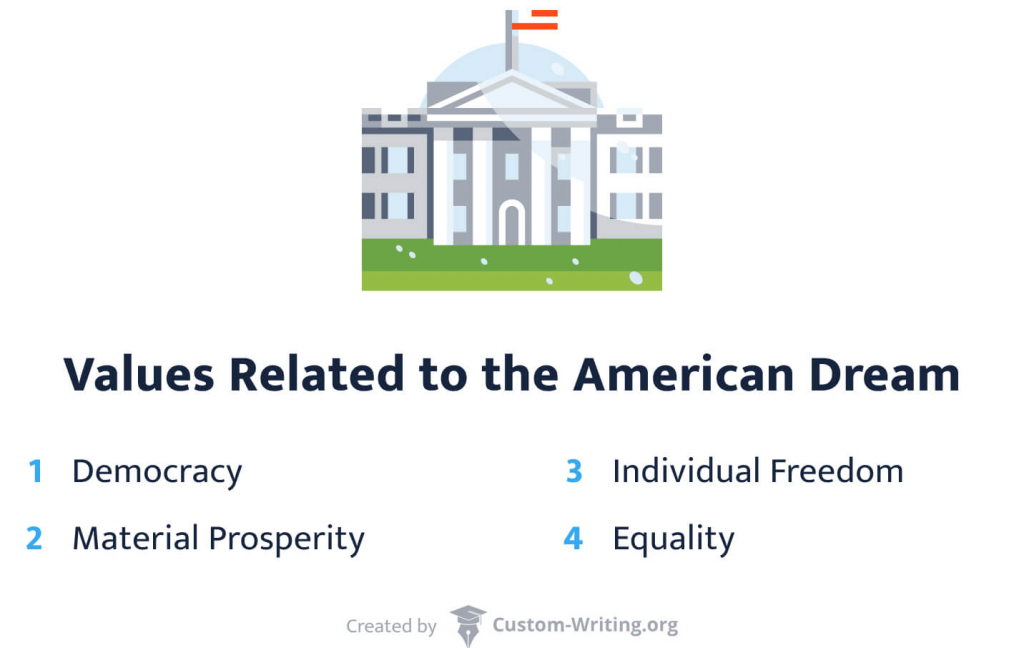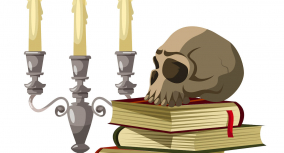The American Dream theme encompasses crucial values, such as freedom, democracy, equal rights, and personal happiness. Even though the concept doesn’t have a fixed definition, it can be grasped through the works of American authors. In American Literature and the Dream, Frederic Carpenter argues that American literature is so distinct from English literature precisely because the concept of the Dream so heavily influences it (1955.)
In this comprehensive article, our custom-writing team provides an in-depth exploration of the American Dream in literature. We will start with the theme’s definition and its connection to the history of the United States. We will then explore the examples from The Great Gatsby, Death of a Salesman, and Of Mice and Men in detail with additional quotes. At the end of the article, you will find a list of essay topics that will aid you in further exploring the theme.
🗽 The American Dream Theme & Its History
We all, as human beings, have the desire to fulfill our dreams. To achieve them, we put forth the effort. The idea behind the phrase “hard work pays off” is closely related to the American Dream. Let’s look at the term’s history and how its meaning evolved.
The term was coined back in 1931 by James Truslow Adams. He defines the American Dream as “the pursuit of a happier and a better life for all citizens of every rank.” In his book Epic of America, he also mentions that the American Dream is “a dream of a land where life should be better and richer and fuller for everyone, with opportunity for each according to ability or achievement.”
The roots of the idea behind the American Dream can be traced back to Colonial Period. First settlers and pilgrims from England saw the States as a promised land of opportunities. They wanted to build a new nation on those lands, free from the old order.
The 1920s or the Jazz Age is the time when the American Dream was at its peak. It is the time of the Harlem Renaissance, economic growth, and technological progress. It is also the time when the idea of the American Dream becomes “corrupted.” In other words, the concept focused on wealth and materialism rather than the ideas of freedom and equality. One of the reasons for that was increased consumerism in American society.
Core American Values & The American Dream
The American Dream played a crucial role in constructing the nation. Since America is a country formed through immigration, people needed something that could unify them.
Unlike other countries, the early colonies featured a mix of nationalities with different histories and cultures. However, people who came to America all shared the hope to find opportunities and achieve independence. The ideas that laid out the basis for constructing the American nation can be referred to as the American Dream.

Although James Adams first used the term in Epic of America, the idea behind the American Dream goes back to the 4th of July, 1776. It is the day The Declaration of Independence was signed. The declaration reflects the values associated with the American Dream.
“We hold these truths to be self-evident, that all men are created equal, that they are endowed by their Creator with certain unalienable Rights, that among these are Life, Liberty, and the pursuit of Happiness.”
Thomas Jefferson, one of the declaration’s authors, explicitly emphasizes the pursuit of happiness. Happiness is the key to everything that the Dream encompasses.
The ideas of Benjamin Franklin have also influenced the formation of the American Dream. In his Autobiography, he tells a story of a man who came from nothing and achieved success through hard work.
Franklin defines himself as an example of an ideal American citizen. He emphasizes that his success can be imitated by any American who strives for success and works hard. Franklin’s life became an example of self-improvement. He believed that if people follow his model, America can become a prosperous country with self-aware citizens.
The American Dream in Literature
From the very beginning, the theme of identity has been prominent in American literature. The US was a land of promise, a New World where everyone dreamed of a just, forward-thinking society. When America began to form its own culture during the revolutionary period, many started to question what it meant to be American.
Literary works of that time were, in a way, a self-discovery. They reflected the ideas, values, and aspirations of the American people. For that reason, along with self-identity, they focused on freedom, racial discrimination, gender, equality, and individualism.
📚 Examples of the American Dream in Literature
It’s true that the theme of the American Dream is present in almost every work of American literature. It is seen as either a positive or a negative phenomenon by various authors.
For instance, the poem I Hear America Singing by Walt Whitman and The Autobiography of Benjamin Franklin describe the American Dream as something that can help the country develop and bring positive changes to society.
In contrast, the following works talk about the vanity of the American Dream:
- The Great Gatsby by F. Scott Fitzgerald,
- Of Mice and Men by John Steinbeck,
- A Raisin in the Sun by Lorraine Hansberry,
- Death of a Salesman by Arthur Miller.
The American Dream in The Great Gatsby
F. Scott Fitzgerald’s novel The Great Gatsby raises a lot of social and psychological questions. One of the book’s topics is the American Dream and how it fails people’s expectations. You can learn more about this and other themes in the novel from our article on the themes in The Great Gatsby.
Fitzgerald depicts the American Dream as something materialistic. It comes in the form of wealth, success, and social status—things that don’t guarantee happiness.
The American Dream posits that anyone who works hard can achieve success in the United States, no matter their social class. The novel questions that idea. Specifically, it criticizes how materialistic the American Dream became when the initial ideas were about freedom and equality. The Great Gatsby shows how consumerism had corroded and corrupted one of the country’s foundational ideas.
How does the Great Gatsby Represent the American Dream?
The protagonist of Fitzgerald’s novel, Jay Gatsby, is the proof that the American Dream, despite people’s expectations, can’t be achieved. From the outside, Gatsby looks like a successful man who paved the way for himself. In reality, however, his life is miserable. He stays an outsider in the eyes of elite society and has no one who truly cares about him.
Jay Gatsby is a romantic character who believes in love and achieving dreams. He pursues wealth and influence as a way to fulfill these dreams. He is too blinded by his passion for Daisy, whom he idealizes, just like people idealize the American Dream.
In the end, Gatsby’s naivety and unwillingness to see the truth bring him to his downfall. Through the character of Jay Gatsby, Fitzgerald shows how corrupted the American Dream became. You can learn more from our article on the characters in The Great Gatsby.
The Great Gatsby: American Dream Quotes
Here are some quotations from Fitzgerald’s novel that demonstrate how the idea of the American Dream is depicted in the book:
I decided to call to him. Miss Baker had mentioned him at dinner, and that would do for an introduction. But I didn’t call to him, for he gave a sudden intimation that he was content to be alone—he stretched out his arms toward the dark water in a curious way, and, far as I was from him, I could have sworn he was trembling. Involuntarily I glanced seaward—and distinguished nothing except a single green light, minute and far away, that might have been the end of a dock. When I looked once more for Gatsby he had vanished, and I was alone again in the unquiet darkness.
The Great Gatsby, Nick Carraway, Chapter 1
He had come a long way to this blue lawn and his dream must have seemed so close that he could hardly fail to grasp it. He did not know that it was already behind him, somewhere back in that vast obscurity beyond the city, where the dark fields of the republic rolled on under the night.
The Great Gatsby, Nick Carraway, Chapter 9
If that was true he must have felt that he had lost the old warm world, paid a high price for living too long with a single dream.
The Great Gatsby, Nick Carraway, Chapter 8
American Dream: Death of a Salesman
The play Death of a Salesman talks about the difference between reality and dreams. The main character, Willy Loman, is a tragic hero. He is flawed because he refuses to accept reality and keeps living in the illusion he had created for himself. Eventually, it leads him to his downfall resulting in his death.
In his play, Arthur Miller criticizes the American society of the 1940s for its materialistic values. The author shows the struggles that each character has to go through in an attempt to achieve their American Dream.
Rather than directly criticizing the American Dream, the play talks about the confusion that comes with it. It condemns how people start to see material success as their way towards happiness and elevate it above everything else. Want to learn more? Feel free to read our summary of Death of a Salesman.
American Dream Quotes: Death of a Salesman
Here are quotations that reflect the idea of the American Dream in Miller’s play:
Work a lifetime to pay off a house. You finally own it, and there’s nobody to live in it.
Death of a Salesman, Willy Loman, Act 1
Biff Loman is lost. In the greatest country in the world a young man with such—personal attractiveness, gets lost. And such a hard worker. There’s one thing about Biff—he’s not lazy.
Death of a Salesman, Willy Loman, Act 1
It’s who you know and the smile on your face! It’s contacts, Ben, contacts! The whole wealth of Alaska passes over the lunch table at the Commodore Hotel, and that’s the wonder, the wonder of this country, that a man can end with diamonds here on the basis of being liked!
Death of a Salesman, Willy Loman, Act 2
American Dream in Of Mice and Men
John Steinbeck’s novella tells the story of two migrant ranch workers who search for new job opportunities. The narrative takes place during the Great Depression. It touches on various topics such as friendship, loneliness, race, gender, and economic class.
The main characters, George and Lennie, wish to own a farm. They hope that they will eventually buy land and fulfill their dream if they work hard. George and Lennie’s dream farm is the representation of the American Dream and its fragility.
In his book, Steinbeck argues that the American Dream of “life, liberty, and the pursuit of happiness” is an illusion and can’t be achieved. The author shows the reality of poor workers trying to make it in America.
Through the book’s characters, it becomes evident that such things as skin color, social status, and gender still affect our position in society. It also reflects how lonely people become while trying to pursue their American Dream.
Of Mice and Men: American Dream Quotes
Here are some interesting quotations that illustrate how the American Dream is portrayed in Steinbeck’s novella:
And these shelves were loaded with little articles, soap and talcum powder, razors and those Western magazines ranch men love to read and scoff at and secretly believe.
Of Mice and Men, Narrator, Chapter 2
I seen too many guys with land in their head. They never get none under their hand.
Of Mice and Men, Crooks, Chapter 4
“Then – it’s all off?” Candy asked sulkily. George didn’t answer his question. George said, “I’ll work my month an’ I’ll take my fifty bucks an’ I’ll stay all night in some lousy cat house. Or I’ll set in some poolroom til ever’body goes home. An’ then I’ll come back an’ work another month an’ I’ll have fifty bucks more.
Of Mice and Men, Candy and George Milton, Chapter 5
📝 American Dream Essay Topics
In this part of the article, we introduce a list of topics on the American Dream. You can use them for inspiration in your essay:
- Describe a character that you think exemplifies the American Dream.
- Write about an author who criticizes the American Dream in his books.
- Analyze a poem that depicts the American Dream as a positive phenomenon.
- Do you think the American Dream is achievable?
- Describe how the American Dream has changed over time.
- Which historical events affect the emergence of the American Dream?
- Describe the American Dream of today.
- Does the American Dream influence world literature?
- How is the American Dream reflected in F. Scott Fitzgerald’s works?
- The Lost Generation and the American Dream.
- The representation of the American Dream in Steinbeck’s Grapes of Wrath.
- Describe Langston Hughes’ version of the American Dream.
- Depiction of the American Dream in movies.
- What is the original meaning of the American Dream?
- Allegory in Edward Albee’s The American Dream.
- The failure of the American Dream.
- Martin Luther King’s version of the American Dream.
- Describe Jack Kerouac’s vision of the American Dream in On the Road.
- Do you think in The Sun Also Rises Hemingway is skeptical about the American Dream?
- Did Benjamin Franklin’s definition of the American Dream get lost?
We hope that you found this article helpful and learned something new. If you liked it, feel free to share it with your friends.
🔍 References
- The American Dream as the Cultural Expression of North American Identity: Academia.edu
- How the American Dream Has Changed Over Time: Williamsburg-James City County Public Schools
- The Colonial American Dream: Encyclopedia.com
- American Dream: Corporate Finance Institute
- The American Dream, Equal Opportunity, and Obtaining the Vote: The University of Maine
- Of Mice and Men: Key Terms and Concepts: San José State University
- The American Dream and Literature: De Paul University
- How the American Dream Turned into Greed and Inequality: World Economic Forum
- Fitzgerald’s Critique of the American Dream: Bridgewater State University
- Defining the Dream: The Institute on the American Dream: Penn State University











